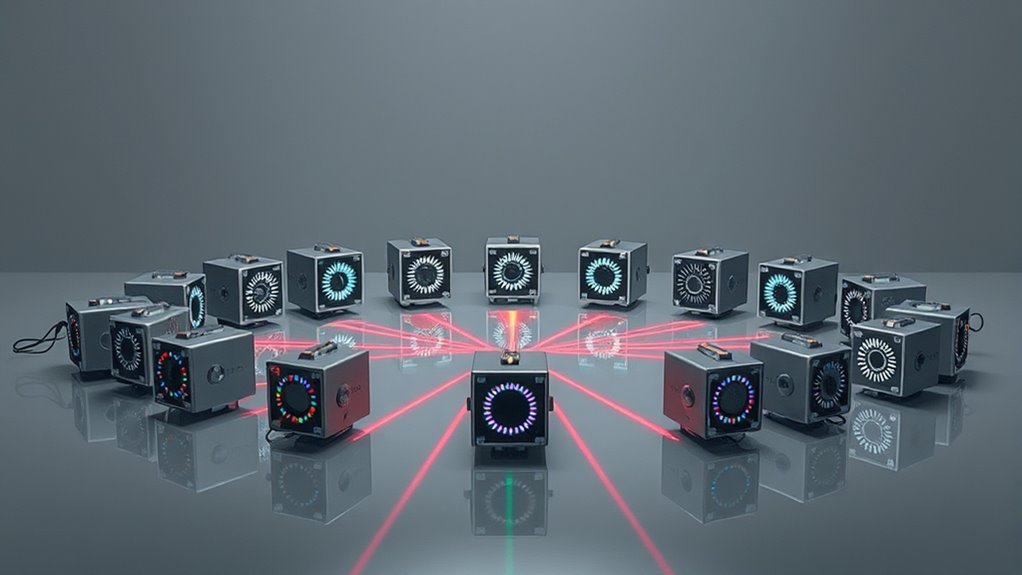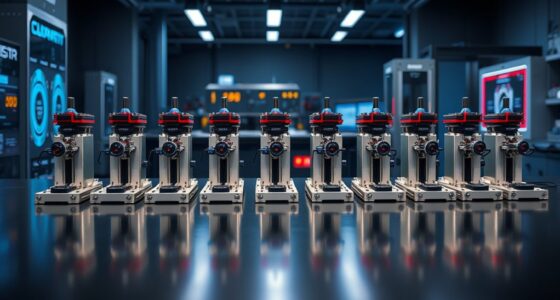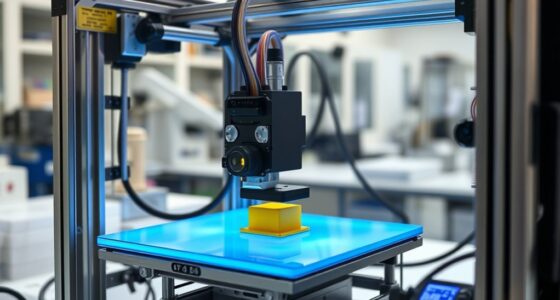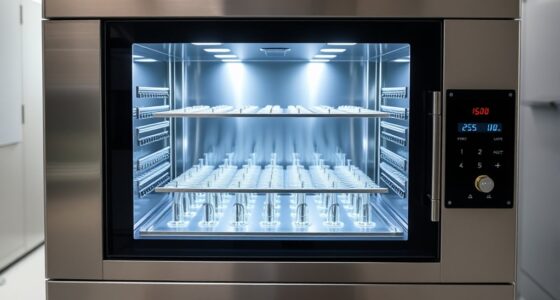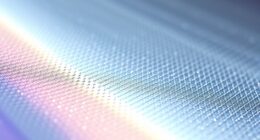If you want the best structured light scanners of 2025, I recommend looking at models that combine precision, speed, and user-friendly features. Top options include advanced portable scanners like the CZUR Shine with OCR for versatile digitizing and the Plustek PS186 for high-volume, detailed work. For accuracy, machines with top-tier sensors and fast processing lead the pack. Keep exploring to discover which scanner fits your needs perfectly and access superior performance.
Key Takeaways
- Prioritize scanners with high resolution and fast processing speeds for precise 3D modeling.
- Select devices with advanced calibration and error correction features to ensure accuracy.
- Consider models offering versatile scanning volumes and compatibility with various materials.
- Focus on scanners with user-friendly interfaces and reliable software for seamless operation.
- Evaluate brands known for innovation, durability, and consistent performance in professional environments.
Wireless OBD2 Scanner XTOOL Anyscan A30M V2.0 for Android & iPhone
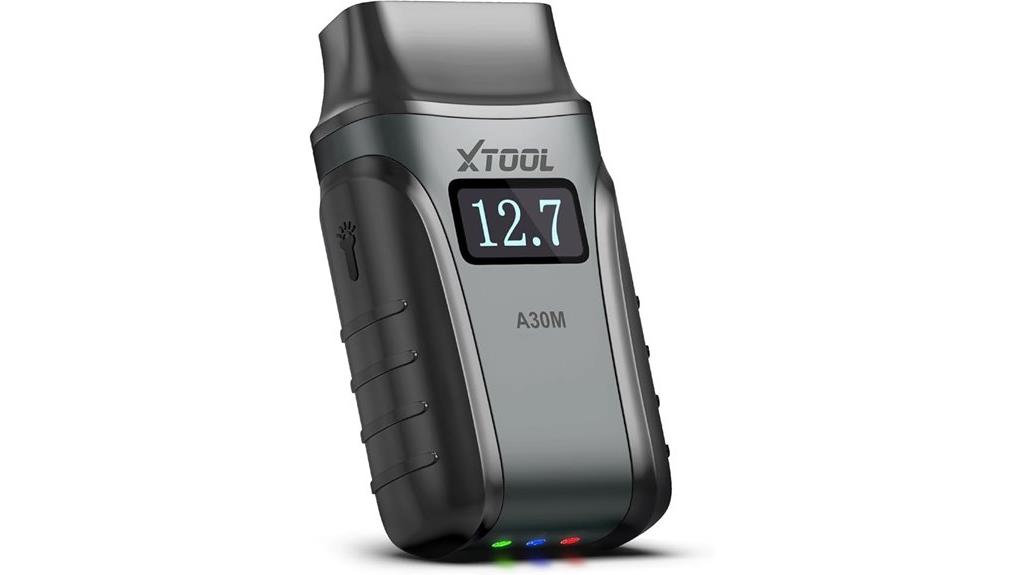
If you’re looking for a versatile, reliable diagnostic tool that works seamlessly with both Android and iPhone devices, the Wireless OBD2 Scanner XTOOL Anyscan A30M V2.0 is an excellent choice. It supports vehicles from 1996 onward across over 85 brands, including U.S., European, and Asian makes. The device offers OE-level diagnostics, full system scans, and active controls like resetting oil or ABS. It connects via Bluetooth up to 33 feet and provides real-time data visualization. With lifetime free updates and strong customer support, it’s perfect for DIYers and professionals alike, delivering exhaustive troubleshooting without ongoing costs.
Best For: DIY car enthusiasts and small workshop owners seeking a versatile, subscription-free diagnostic tool compatible with both Android and iPhone devices.
Pros:
- Supports a wide range of vehicles from 1996 onward, covering over 85 brands globally.
- Offers OE-level diagnostics, full system scans, and active controls including bi-directional testing.
- Provides free lifetime updates, ensuring the device stays current with evolving vehicle technology.
Cons:
- The app file size is large (around 1.1GB), which may require significant storage space on devices.
- Connection speed and stability can vary depending on the phone or tablet used.
- Some advanced features like FCA AutoAuth require separate registration and additional fees.
XTOOL IP900S OBD2 Diagnostic Scanner with Topology Mapping
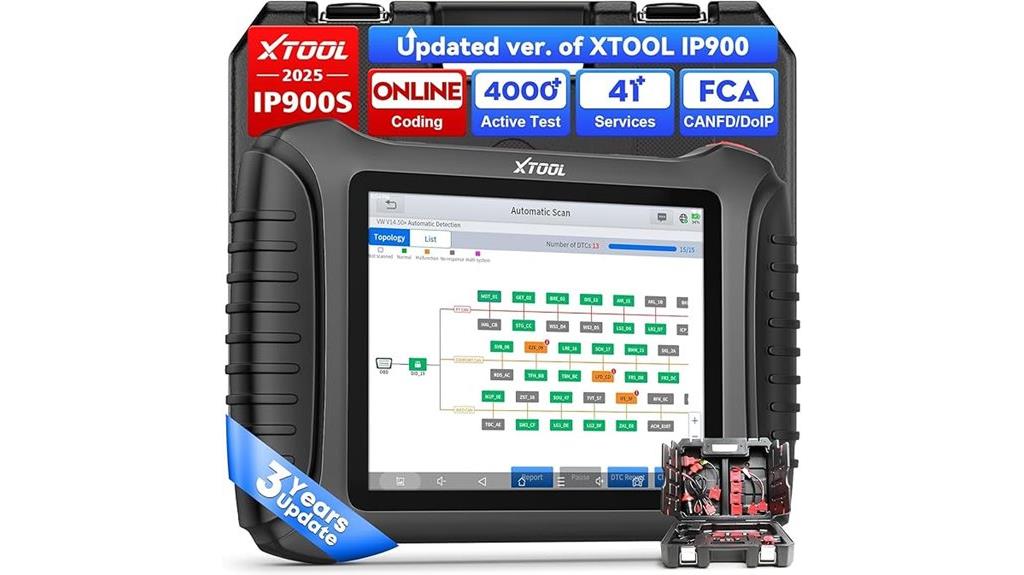
The XTOOL IP900S OBD2 Diagnostic Scanner with Topology Mapping stands out as an ideal choice for professional mechanics and advanced DIYers who need extensive vehicle network analysis. Its topology mapping feature visually displays the physical connections and communication paths between control units, making complex network issues easier to diagnose. Supported by OE-level all-system diagnosis, it covers ECM, TCM, ABS, SRS, and more, with full system scans, live data streams, and DTC reading. With 3-year free updates, lifetime technical support, and compatibility with over 10,000 vehicles worldwide, it’s a powerful tool for precise and efficient vehicle diagnostics.
Best For: professional mechanics and advanced DIYers seeking comprehensive vehicle network analysis and OE-level diagnosis.
Pros:
- Features topology mapping for visualizing complex vehicle network connections.
- Supports extensive OE-level all-system diagnosis including ECU, TCM, ABS, and SRS.
- Comes with 3-year free updates and lifetime technical support, ensuring long-term reliability.
Cons:
- May have a steep learning curve for beginners unfamiliar with advanced diagnostic functions.
- The device’s extensive features could be overwhelming for casual or occasional users.
- Higher price point compared to basic OBD2 scanners with limited capabilities.
Slide Viewer Light Box for Scanning Negatives and Slides
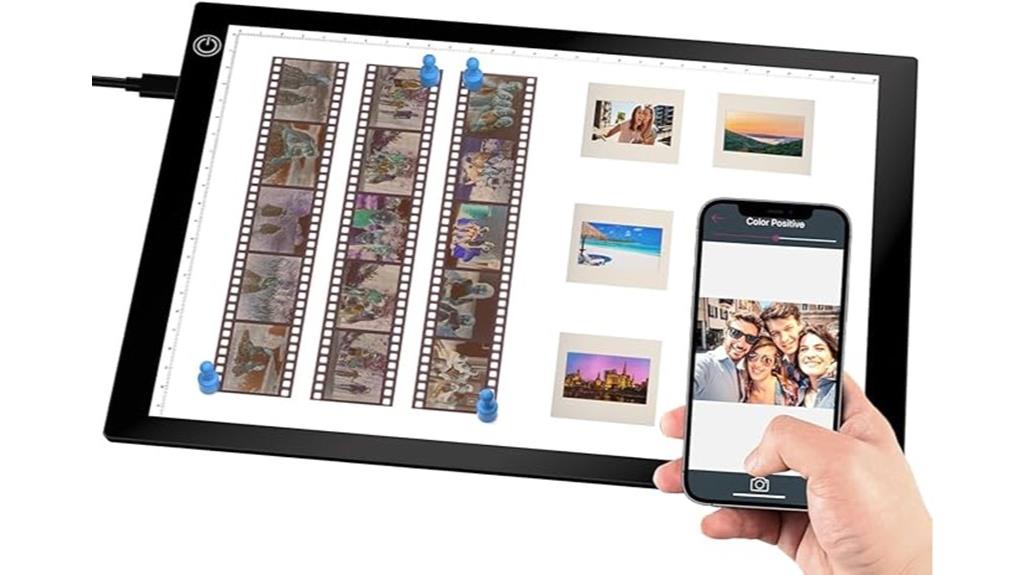
A slide viewer light box is an essential tool for anyone looking to digitize and view negatives and slides with ease. I love its ultra-thin, lightweight design—just 0.2 inches thick—and the large viewing area that fits multiple slides and negatives. The high-quality light guide and adjustable LED brightness guarantee even illumination, making details pop. It features magnets for easy slide attachment, measurement scales for precision, and compatibility with free apps like SlideScan and FilmBox. Whether for scanning, tracing, or viewing, this device is user-friendly, portable, and versatile, making it perfect for both amateurs and professionals aiming for quick, high-quality digitization.
Best For: hobbyists, photographers, and professionals seeking a portable, easy-to-use device for digitizing negatives and slides with high-quality backlighting and versatile viewing options.
Pros:
- Ultra-thin, lightweight design for portability and ease of use
- Adjustable LED brightness and measurement scales for precise viewing and scanning
- Compatible with free apps like SlideScan and FilmBox for seamless digitization and sharing
Cons:
- LED lines may appear in photos, affecting image quality
- Brightness may be insufficient for dark or dense slides
- Some users prefer direct phone photography over app-based scanning methods
Canon imageFORMULA R10 Portable Document Scanner
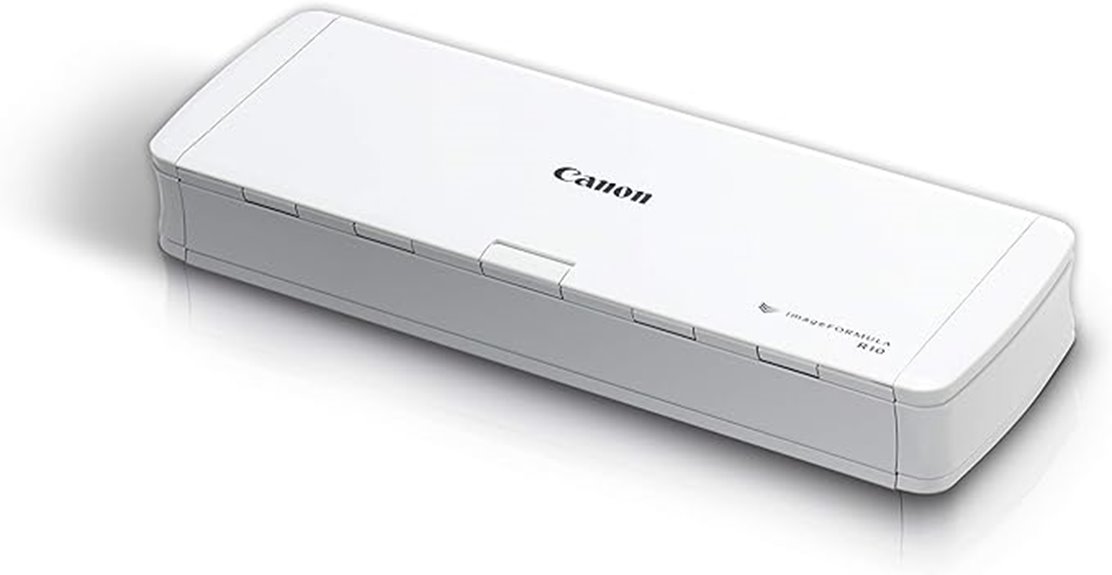
Designed for mobile professionals and remote workers, the Canon imageFORMULA R10 Portable Document Scanner offers a lightweight, USB-powered solution that easily fits into any workspace. It’s perfect for scanning receipts, reports, business cards, and more, with duplex scanning that handles both sides simultaneously. Its speed of up to 12 pages per minute and 20-sheet automatic feeder make quick work of daily tasks. Compatible with Windows and Mac, it requires no setup—just plug in and start scanning. The scanner produces high-quality digital files like searchable PDFs and JPEGs, with easy preview and editing features, making digitization effortless wherever you are.
Best For: mobile professionals, remote workers, and small offices seeking a lightweight, versatile scanner for quick and efficient digitization of various media.
Pros:
- Compact and lightweight design ideal for on-the-go scanning
- Duplex scanning speeds up workflow by handling both sides simultaneously
- Compatible with Windows and Mac without requiring additional software installation
Cons:
- Suggested daily volume of 500 scans may be limiting for high-volume users
- Limited to USB power, which may be inconvenient without USB ports nearby
- Basic software features might require manual updates for advanced functionalities
Epson Workforce ES-580W Wireless Document Scanner with ADF
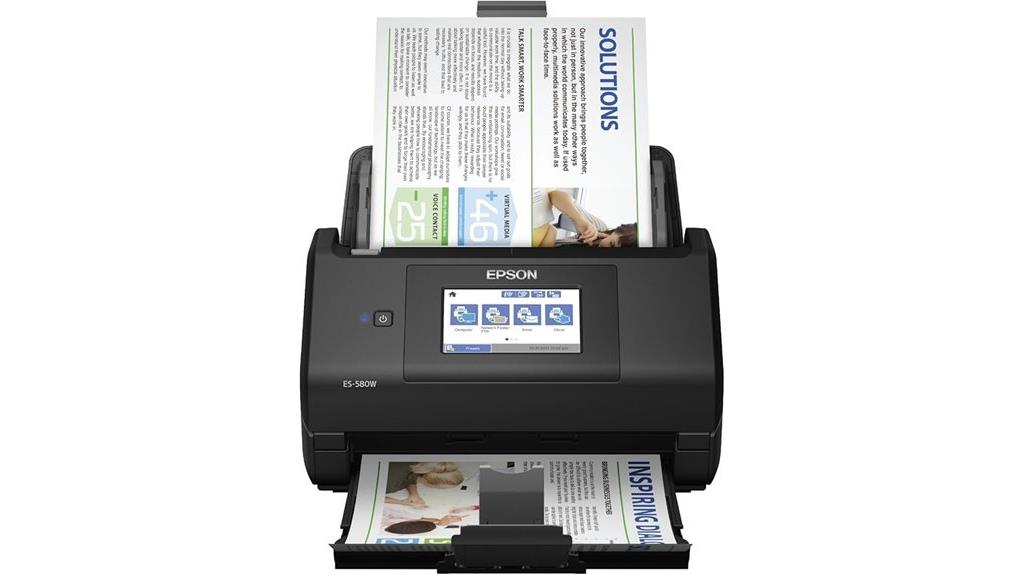
If you’re seeking a reliable, high-speed scanner for busy office environments or large-scale archiving projects, the Epson Workforce ES-580W Wireless Document Scanner with ADF stands out as an excellent choice. It offers fast, color duplex scanning at up to 35 pages per minute, with a 4.3-inch touchscreen for easy operation. Its 100-sheet ADF handles various paper sizes, and wireless connectivity enables direct scans to smartphones, cloud services, or email. Compatible with Windows and Mac, it supports OCR for searchable PDFs and file conversions. Compact and reliable, many users praise its speed, accuracy, and ability to process large volumes, making it ideal for demanding workflows.
Best For: professionals and large organizations needing fast, reliable, high-volume document scanning with wireless and multi-page capabilities.
Pros:
- High-speed color duplex scanning at up to 35 pages per minute.
- Supports large batch processing with a 100-sheet ADF and handling various paper sizes.
- Wireless connectivity allows direct scanning to mobile devices, cloud services, and email without a computer.
Cons:
- Photo resolution could be improved beyond 600 dpi for better image detail.
- Some users experience connectivity issues with certain browsers or OS versions, like Windows 11 via Firefox or DuckDuckGo.
- Limited output formats; lacks options like GIF or BMP, and advanced image editing features.
ScanSnap iX1300 Compact Wireless/USB Document Scanner
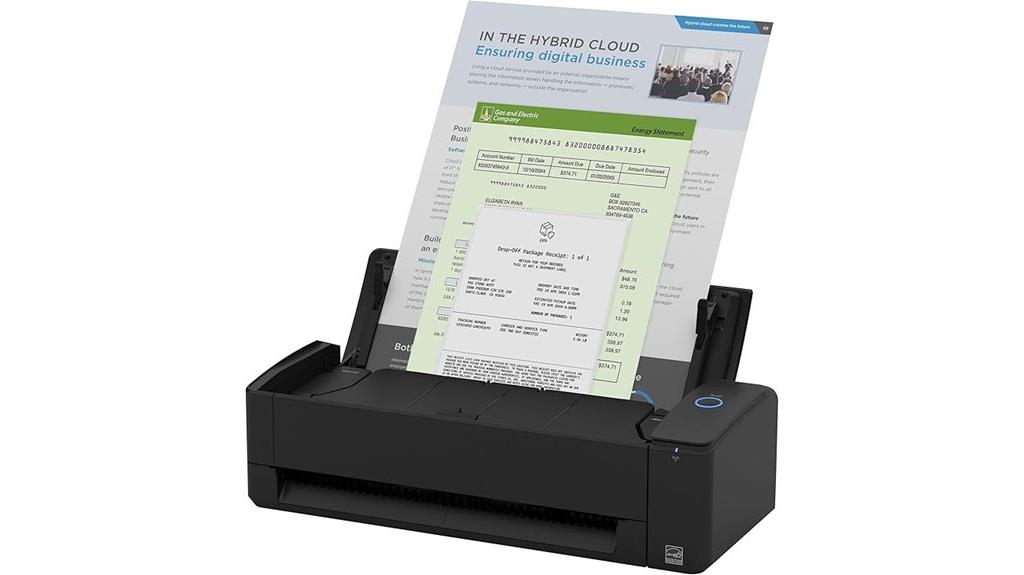
The ScanSnap iX1300 is an ideal choice for users who need a compact, versatile scanner that fits easily into small workspaces without sacrificing speed or quality. Its space-saving design measures just 4.5 x 11.7 x 3.3 inches and weighs only 4.4 pounds, making it highly portable. It handles various documents, including photos, receipts, business cards, and thick items, with duplex scanning at up to 30 pages per minute. Connectivity options include USB and Wi-Fi, allowing direct scans to multiple devices and cloud services. Its automatic features, like de-skew and blank page removal, guarantee high-quality results with minimal effort.
Best For: users seeking a compact, high-speed scanner for versatile document, photo, and card digitization in small spaces and on various devices.
Pros:
- Space-saving, lightweight design ideal for small workspaces and portability
- Fast duplex scanning at up to 30 pages per minute with high-quality image output
- Wireless and USB connectivity options for flexible scanning directly to multiple devices and cloud services
Cons:
- Setup can be complex for non-technical users, especially with software configuration
- Limited resolution at 600dpi, with no higher 1200dpi option for more detailed scans
- Occasional connectivity issues like Wi-Fi indicator flashing may require troubleshooting
Epson Workforce ES-C220 Compact Desktop Document Scanner
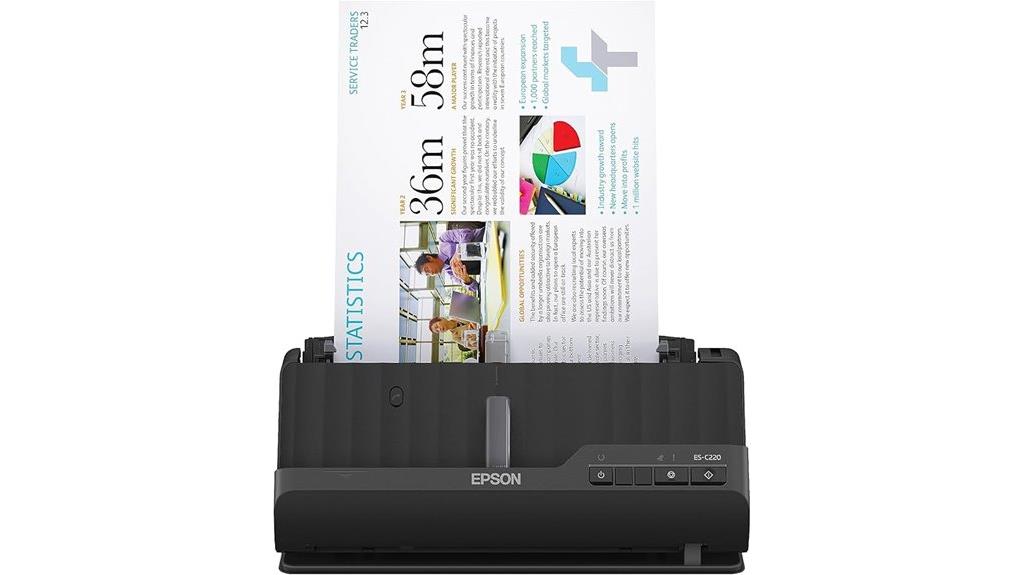
For professionals and small offices needing a reliable, space-saving scanner, the Epson Workforce ES-C220 stands out with its ultra-compact design that reduces desk footprint by 60%. Its lightweight build makes it highly portable, perfect for mobile or shared workspaces. It scans both sides of documents quickly—up to 30 pages per minute—thanks to its efficient dual-sided scanning and 20-page auto feeder. The device handles various document types, including cards and passports, with intelligent features like cropping and background removal. Coupled with Epson ScanSmart software for easy operation, this scanner offers a blend of performance, versatility, and convenience, backed by Epson’s trusted reputation.
Best For: small offices and professionals who need a reliable, space-saving scanner with fast double-sided scanning capabilities.
Pros:
- Ultra-compact design reduces desk space by 60%, ideal for limited areas
- Fast two-sided scanning at up to 30 ppm, increasing productivity
- Supports a wide range of documents, including cards and passports, with intelligent image adjustments
Cons:
- May be less suitable for high-volume scanning environments requiring larger capacity
- Limited to desktop use; not designed for heavy-duty or industrial scanning tasks
- Software features may require some familiarity for optimal use
Brother ADS-1300 Desktop Scanner with 30ppm Scan Speed
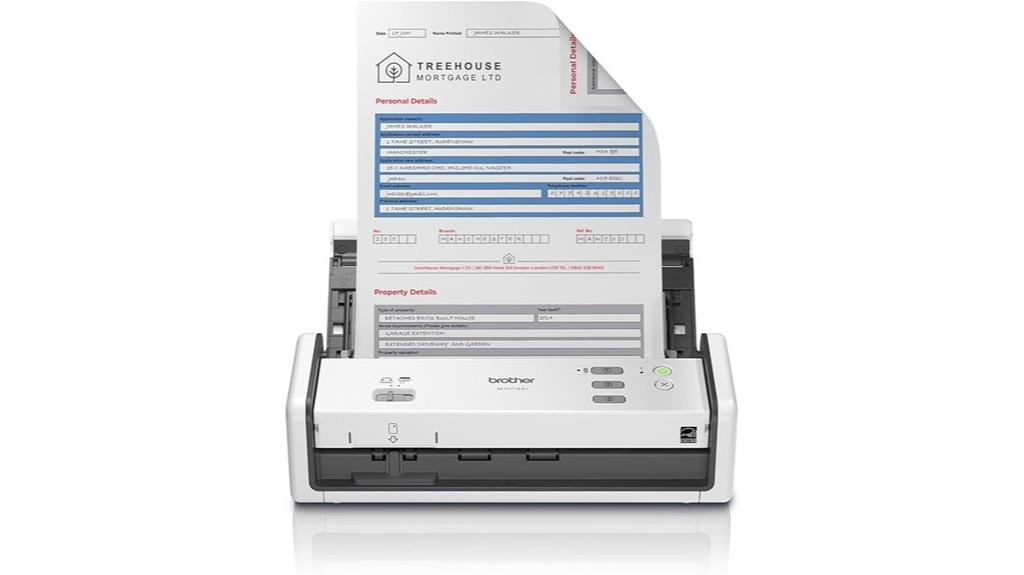
Designed for busy professionals and small office setups, the Brother ADS-1300 Desktop Scanner delivers rapid scanning speeds of up to 30 pages per minute, making it ideal for those who need to quickly digitize large volumes of documents. Its compact and lightweight design guarantees portability, whether at work, home, or on the go. With a 20-page automatic document feeder and single-pass double-sided scanning, it handles large jobs efficiently. The scanner supports multiple document types, including business cards and ID badges, and connects via USB for easy setup. Bundled software enhances file organization, making your scanned documents readable and searchable with ease.
Best For: busy professionals and small office users who need fast, portable, and efficient document scanning solutions.
Pros:
- Rapid scanning speeds of up to 30 pages per minute for high productivity
- Compact, lightweight design for easy portability at work, home, or travel
- Supports multiple document types, including business cards and ID badges, with versatile scanning options
Cons:
- Limited to USB connectivity, lacking wireless options
- May require software setup for optimal file organization and editing
- Small automatic document feeder capacity (20 pages) might necessitate frequent reloading for large jobs
Epson WorkForce ES-50 Portable Sheet-Fed Document Scanner for PC and Mac

Looking for a portable scanner that can handle quick, on-the-go document digitization without sacrificing quality? The Epson WorkForce ES-50 is the lightest, fastest mobile scanner in its class, capable of scanning a page in just 5.5 seconds. It supports documents up to 8.5 x 72 inches, including receipts and ID cards. USB-powered, it requires no batteries or external power, making it highly portable. With Epson ScanSmart software and Nuance OCR, you can easily review, organize, and create searchable PDFs or editable files. Compact and lightweight at under 10 ounces, it’s ideal for light professional or casual use, offering speed, quality, and convenience.
Best For: light professional or casual users who need a portable, fast, and reliable scanner for occasional document digitization on the go.
Pros:
- Ultra-lightweight and compact design, weighing under 10 ounces for easy portability
- Fast scanning speed of up to 5.5 seconds per page, suitable for quick document capture
- Supports a variety of document types, including receipts, ID cards, and long pages up to 72 inches
Cons:
- May struggle with faint marks or pencil sketches, limiting some document types
- Not ideal for high-volume batch scanning or heavy professional use
- Occasional issues with packaging or hardware durability, such as shipping damage or loose components
ANCEL OBD2 Scanner FX6100 Diagnostic Tool with Active Test and Reset Services
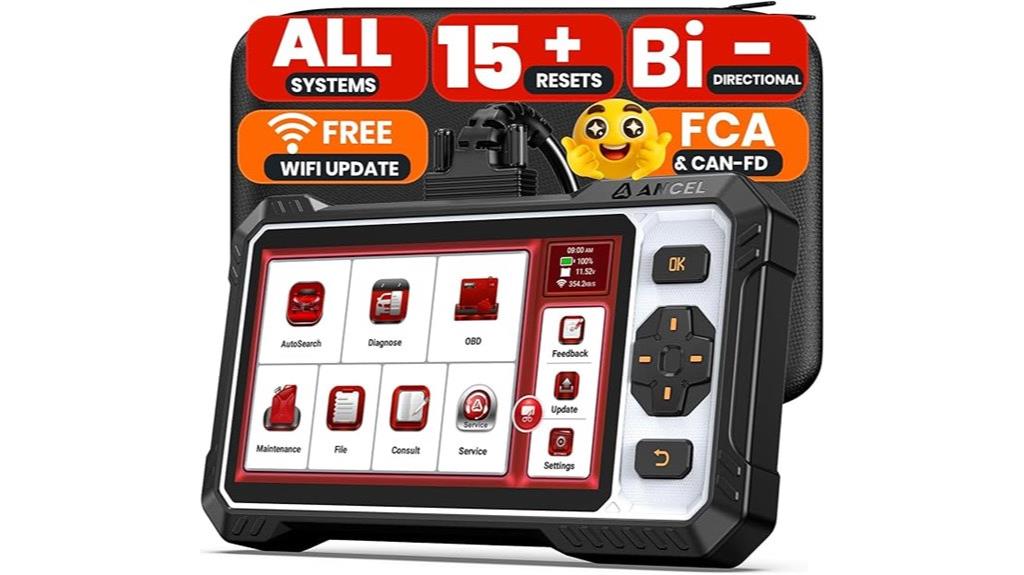
If you’re searching for a reliable diagnostic tool that offers thorough active testing and resetting capabilities, the ANCEL FX6100 OBD2 Scanner stands out as an excellent choice. It supports all vehicle systems via OBD2, connecting with over 100,000 models worldwide from 2006 onward. The device features bi-directional control, allowing me to perform active tests on components like injectors, windows, and wipers, plus resets for oil, ABS, TPMS, and more. Its Android-powered interface with a clear HD display ensures quick, responsive diagnostics. Despite not supporting vehicle programming, it’s perfect for fault detection, system resets, and active component testing, making it a versatile tool for both professionals and DIY enthusiasts.
Best For: DIY enthusiasts, repair shops, and professionals seeking a comprehensive, easy-to-use diagnostic tool with active testing and reset functions for a wide range of vehicle systems.
Pros:
- Supports all vehicle systems via OBD2 with extensive coverage of over 100,000 models worldwide.
- Features bi-directional control for active tests and system resets, enhancing diagnostic accuracy.
- Powered by Android with a responsive HD display, offering clear visuals and smooth operation.
Cons:
- Does not support vehicle programming or coding functions.
- Lacks advanced topology features like graphical module network views.
- Some modules may appear unsupported or inactive depending on vehicle compatibility.
Brother DS-740D Duplex Compact Mobile Document Scanner
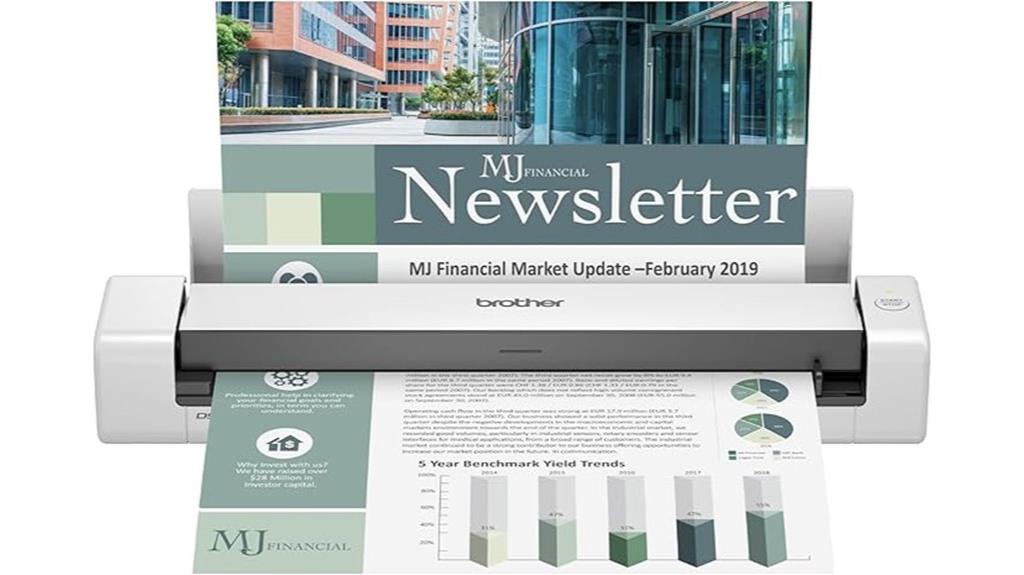
The Brother DS-740D Duplex Compact Mobile Document Scanner stands out as an ideal choice for professionals who need fast, high-quality scanning on the go. Its compact, lightweight design measures just 11.9 x 2.5 x 1.8 inches and weighs only 2.24 pounds, making it easy to carry and store. It supports duplex scanning at up to 16 pages per minute, handling various document types like receipts and ID cards efficiently. Powered via USB, it’s perfect for mobile use without needing an outlet. Its user-friendly software offers automatic image enhancements, making it simple to produce clear, professional scans in limited space.
CZUR Shine Ultra Portable Document Scanner with OCR, USB Book & Document Camera for Windows & Mac
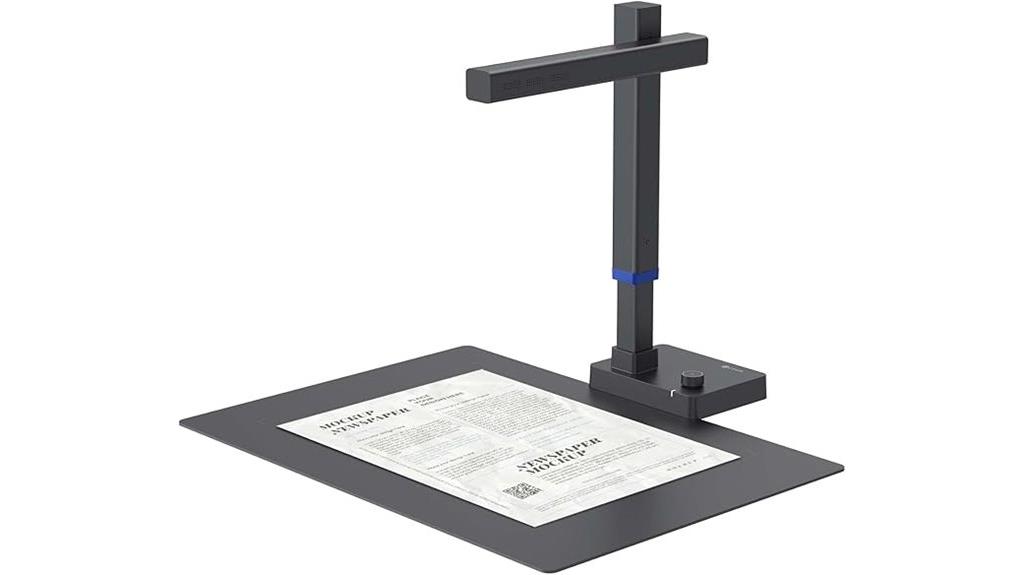
For professionals and students who need a portable yet powerful scanning solution, the CZUR Shine Ultra stands out thanks to its high-resolution CMOS 13MP camera and fast scanning speed. Supporting both Windows and Mac, it handles documents up to A3 and A4 sizes with impressive clarity—around 340 DPI for A4. Its smart features include auto cropping, flattening curved pages, and OCR for converting images into editable files. Lightweight at 4 pounds, it’s easy to transport, with a foldable design and foot pedal for hands-free operation. Perfect for digitizing books, notes, or photos quickly and accurately, it’s a versatile tool for archival and everyday use.
Best For: professionals, students, and archival enthusiasts seeking a portable, high-quality scanner for quick and accurate digitization of documents, books, and photos.
Pros:
- High-resolution 13MP CMOS camera with excellent image clarity and OCR accuracy
- Fast scanning speed of approximately 1 second per page, suitable for large projects
- Compact, lightweight, foldable design with adjustable height and foot pedal for ease of use
Cons:
- Glare and reflection issues on glossy or shiny pages can affect scan quality
- Potential challenges with initial software installation and hardware recognition
- Build quality may feel flimsy or cold to touch, with occasional hardware reliability concerns
Plustek PS186 Desktop Document Scanner
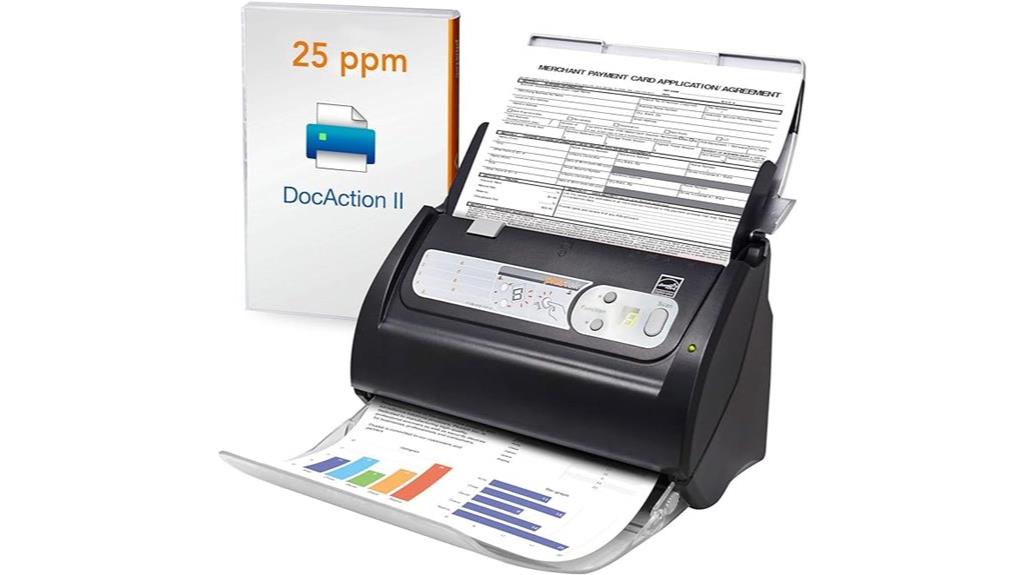
Designed for busy offices and professionals who need efficient document management, the Plustek PS186 Desktop Document Scanner offers a robust 50-page Auto Document Feeder that streamlines high-volume scanning tasks. It’s compatible with Windows 7 through 11 on both Intel and AMD systems, ensuring broad usability. With support for up to 255 personalized scan settings via the Single Touch feature, customization is seamless. The scanner transforms paper documents into searchable, editable files using OCR technology and supports saving as searchable PDFs. Features like barcode recognition, auto rotate, crop, deskew, and blank page removal make organizing complex documents effortless. Plus, easy file transfer to FTP servers or NAS simplifies sharing and storage.
Best For: busy offices and professionals needing efficient high-volume document scanning with customization and advanced organization features.
Pros:
- High-capacity 50-page Auto Document Feeder for efficient batch scanning
- Supports up to 255 personalized scan settings via Single Touch for easy customization
- Includes OCR technology to create searchable and editable digital files
Cons:
- Limited compatibility to Windows 7 through 11, potentially excluding older or alternative OS users
- May require downloading drivers from the website, which could be an extra step for some users
- No mention of wireless connectivity, limiting options for wireless sharing
Factors to Consider When Choosing Structured Light Scanners
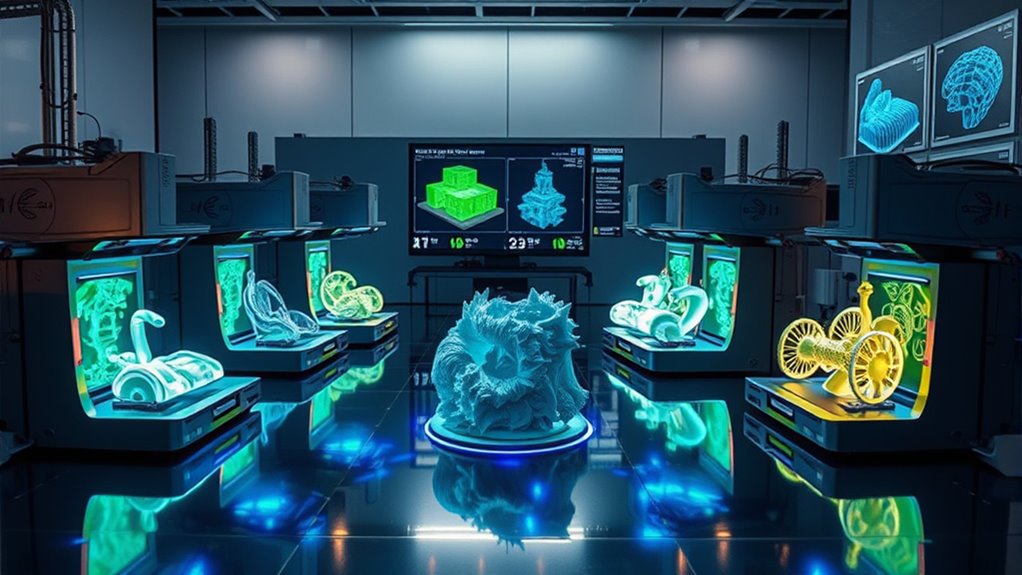
When selecting a structured light scanner, I focus on factors like resolution and accuracy to guarantee detailed results, as well as speed and throughput to meet project deadlines. Compatibility with existing software and ease of use are also vital for seamless operation, while cost and support influence long-term value. Considering these points helps me choose a scanner that fits my specific needs and budget.
Resolution and Accuracy
Choosing a structured light scanner hinges considerably on its resolution and accuracy, as these factors directly impact the quality of the 3D models produced. Higher resolution, measured in megapixels or DPI, captures more detail, resulting in finer, more precise scans. Accuracy, often indicated by measurement tolerance (like ±0.1 mm), guarantees the scanner correctly captures spatial dimensions. The quality of the projector’s pattern and the camera’s sensor play essential roles in detail and fidelity. Calibration and environmental conditions, such as lighting, also influence measurement precision. For applications like industrial inspection or reverse engineering, consistent resolution and accuracy are indispensable. When evaluating scanners, I focus on both resolution and accuracy to confirm the device meets the specific demands of detailed, reliable 3D modeling.
Speed and Throughput
Speed and throughput are key factors that influence how effectively a structured light scanner can meet your project demands. Faster scanners, measured in frames per second or points per second, enable quicker data capture, reducing overall scan times. High throughput is essential when scanning multiple objects or large volumes, making workflows more efficient. Depending on the complexity and size of the item, scan times can range from just a few seconds to several minutes. The device’s data processing power also impacts how many scans it can perform within a given period. To optimize speed and throughput, you may need to balance resolution and accuracy with processing capabilities. Selecting a scanner with the right speed guarantees you meet your deadlines without sacrificing data quality.
Compatibility and Software
Ensuring compatibility between your structured light scanner and your existing software environment is crucial for smooth and efficient workflows. First, verify that the scanner’s software supports your operating system—whether Windows, Mac, or Linux—to prevent technical issues. Next, confirm that it can export in the file formats you need, such as OBJ, STL, or PLY, to facilitate seamless integration with your 3D modeling tools. Look for features like calibration, alignment, and noise reduction within the software to improve scan accuracy and quality. Additionally, check if the software integrates with CAD or design programs, streamlining your workflow. Finally, ensure the scanner provides regular firmware or software updates, keeping it compatible with evolving hardware standards and emerging file formats.
Ease of Use
When selecting a structured light scanner, ease of use is a key factor that can substantially impact your workflow. A user-friendly scanner features a simple calibration process that takes less than five minutes, saving you time and frustration. Intuitive software with clear controls reduces the learning curve, making it easier for new operators to get started quickly. Guided setup instructions help guarantee proper alignment and ideal results without needing technical expertise. Compatibility with common operating systems and minimal hardware requirements allow for seamless integration into existing setups. Additionally, built-in troubleshooting and automatic error detection help resolve issues swiftly, maintaining consistent performance. Overall, a scanner with these user-focused features streamlines operations and boosts productivity, making your scanning experience more efficient and less stressful.
Cost and Support
Choosing a structured light scanner involves more than just considering ease of use; it’s also important to evaluate the costs involved and the level of support provided. Prices can range from a few hundred to several thousand dollars, depending on features, resolution, and application scope. Higher-priced models often include better support, such as regular firmware updates, technical assistance, and extensive warranties. They may also offer on-site service and extensive online resources. Conversely, budget-friendly options tend to have limited support, slower response times, and restrictions on updates or troubleshooting. When selecting a scanner, consider long-term expenses like software licenses and maintenance. Reliable support ensures smoother operation and minimizes downtime, making it a vital factor alongside initial cost.
Frequently Asked Questions
How Do Different Lighting Conditions Affect Structured Light Scanner Accuracy?
Different lighting conditions can considerably impact a structured light scanner’s accuracy. Bright ambient light, especially sunlight, can wash out the projected patterns, making it harder for the scanner to capture precise details. Conversely, dim or controlled lighting enhances pattern contrast and improves accuracy. I always recommend scanning in consistent, moderate lighting environments to guarantee ideal results, avoiding shadows and glare that can distort the scan data.
What Maintenance Routines Extend the Lifespan of High-Precision Scanners?
Think of your high-precision scanner as a fine-tuned instrument, and regular maintenance is its melody. I regularly clean the lenses with a lint-free cloth, keep the device in a dust-free environment, and calibrate it according to the manufacturer’s instructions. I also check cables and connections for wear. These routines make sure my scanner stays accurate and reliable, giving me precise results for years to come.
Are There Compatibility Issues With Specific Software or Hardware Setups?
Yes, I’ve found that compatibility issues can arise with certain software or hardware setups. To prevent this, I always check the scanner’s specifications against my existing systems before buying. I also keep firmware and software updated, and I consult manufacturer guidelines. If issues come up, I contact support promptly. Staying informed and maintaining updates helps me guarantee smooth operation without compatibility headaches in my scanning projects.
How Does Scanner Resolution Impact Detailed 3D Modeling?
Think of scanner resolution as the brushstroke detail on a canvas; higher resolution captures every tiny nuance. When I use a high-res scanner, I get crisp, intricate 3D models that reveal even the smallest features. Lower resolution, however, turns my models into blurry sketches. So, if you want detailed, lifelike results, investing in a scanner with higher resolution is essential to bring every detail vividly to life.
What Are the Latest Advancements in Real-Time Data Processing for Scanners?
I’ve seen recent advancements in real-time data processing that markedly boost scanner performance. New algorithms now enable faster point cloud generation and more accurate data alignment on the fly. This means I can scan complex objects seamlessly, with minimal lag. Enhanced processing power and smarter software allow for immediate feedback and correction, making my workflow more efficient. These innovations truly transform how quickly and accurately I can create detailed 3D models.
Conclusion
Choosing the right structured light scanner is like finding the perfect tool in a toolbox—each one has its unique strength. Whether you need precision for detailed 3D models or speed for quick scans, there’s a device out there for you. Stay informed and pick wisely, and you’ll discover new levels of accuracy and performance. After all, the right scanner can turn complex tasks into smooth sailing, just like a trusted compass guiding your way.
